Unilever: Organisational Beliefs, Attitudes, and Workplace Behaviour
VerifiedAdded on 2023/06/08
|17
|5875
|432
Report
AI Summary
This report examines the impact of organisational beliefs, attitudes, and value systems on workplace behaviour, using Unilever as a case study. It explores management theories, including human relations, scientific management, and contingency theory, and their influence on organisational behaviour. The report details how beliefs, values, and attitudes shape employee conduct and affect customer satisfaction and productivity. Furthermore, it addresses tailoring workplace changes for the post-COVID mindset, focusing on adapting to new employee expectations regarding hygiene, space, and social interaction. The report provides recommendations for Unilever and other organisations to foster a comfortable and effective workplace environment, including implementing touch-less technology and de-densification strategies. Finally, the report includes a reflective learning journal, summarizing learning and teaching sessions, showing personal experiences on the topic, and the report concludes with recommendations for business resilience.
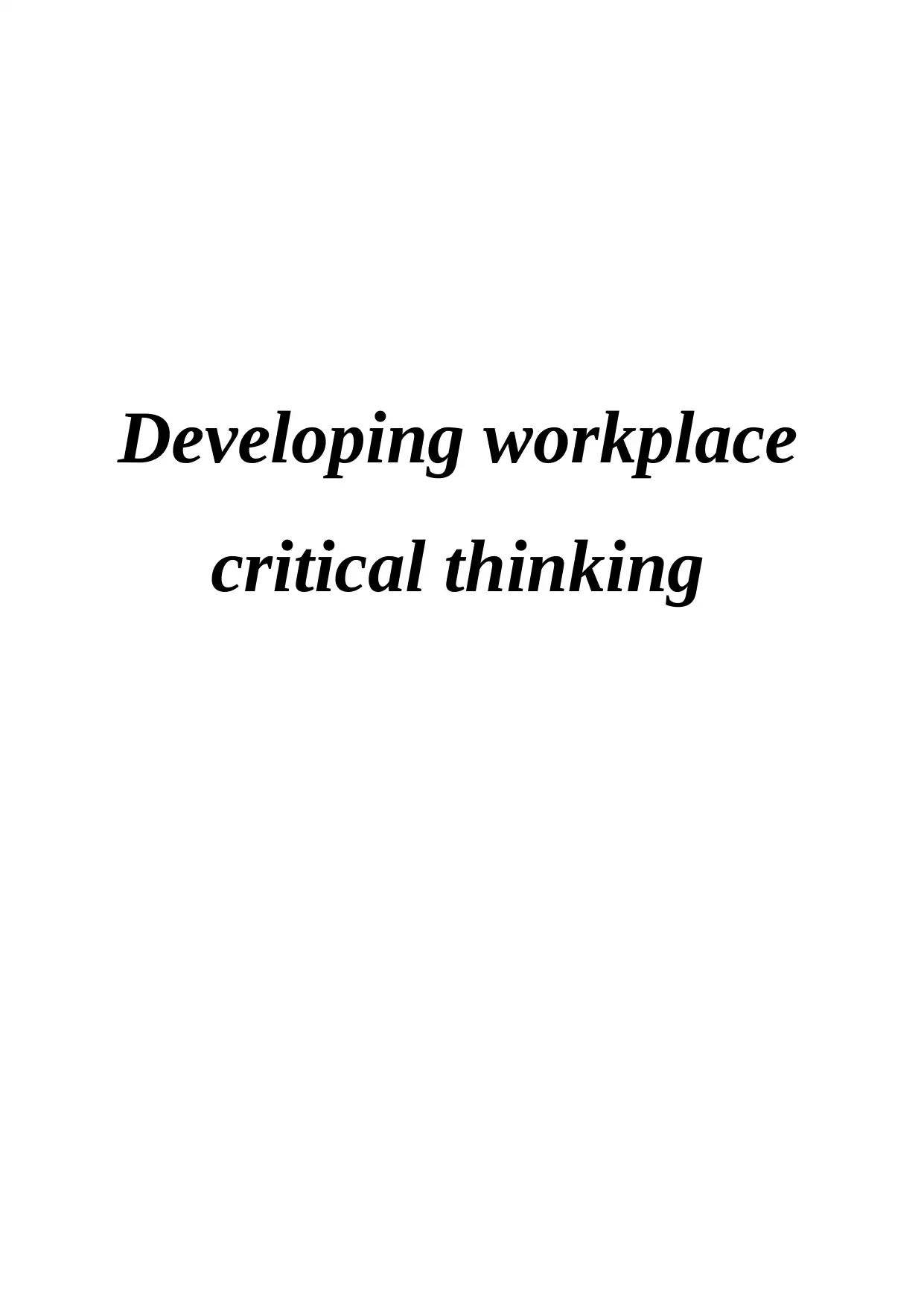
Developing workplace
critical thinking
critical thinking
Paraphrase This Document
Need a fresh take? Get an instant paraphrase of this document with our AI Paraphraser
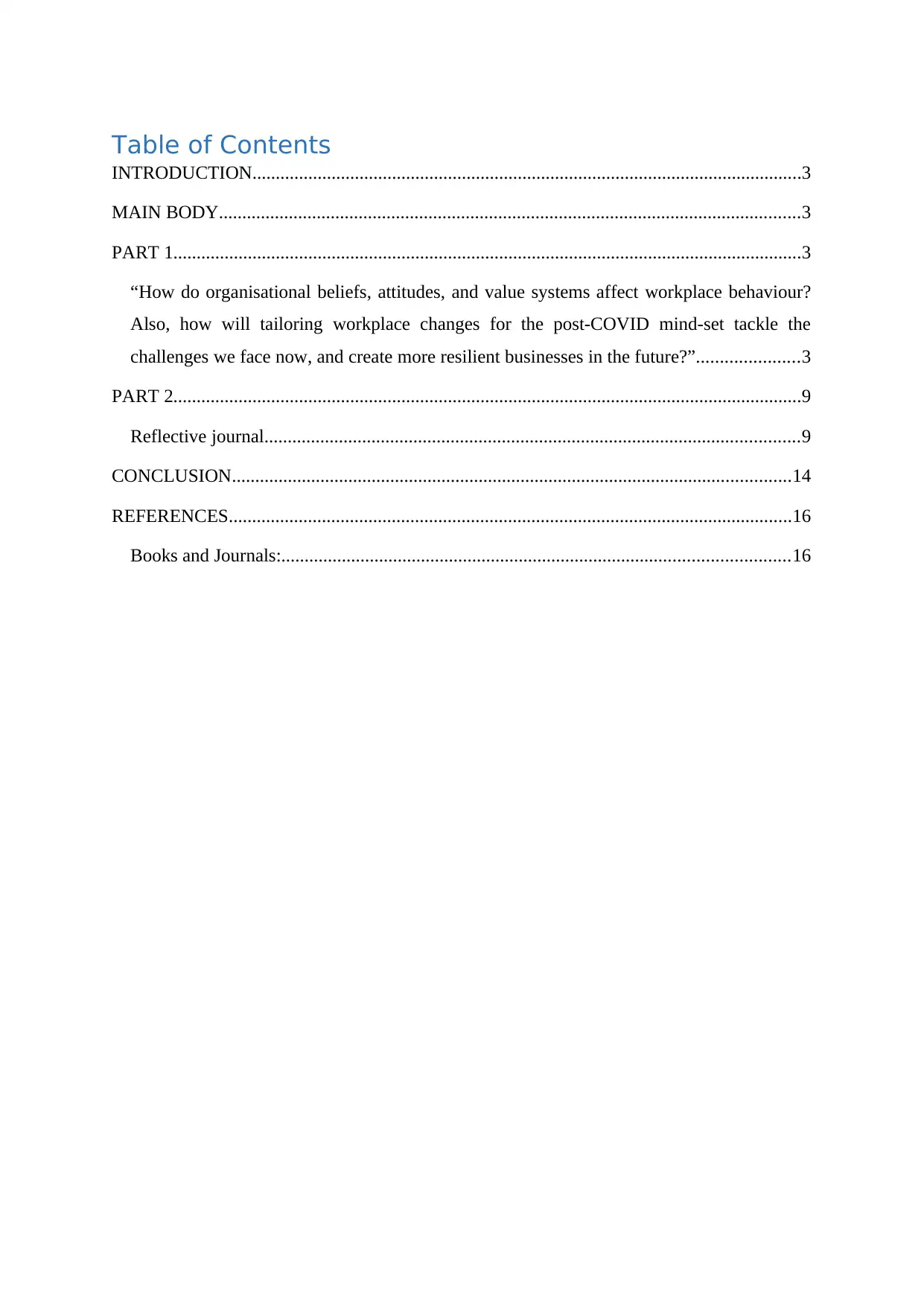
Table of Contents
INTRODUCTION......................................................................................................................3
MAIN BODY.............................................................................................................................3
PART 1.......................................................................................................................................3
“How do organisational beliefs, attitudes, and value systems affect workplace behaviour?
Also, how will tailoring workplace changes for the post-COVID mind-set tackle the
challenges we face now, and create more resilient businesses in the future?”......................3
PART 2.......................................................................................................................................9
Reflective journal...................................................................................................................9
CONCLUSION........................................................................................................................14
REFERENCES.........................................................................................................................16
Books and Journals:.............................................................................................................16
INTRODUCTION......................................................................................................................3
MAIN BODY.............................................................................................................................3
PART 1.......................................................................................................................................3
“How do organisational beliefs, attitudes, and value systems affect workplace behaviour?
Also, how will tailoring workplace changes for the post-COVID mind-set tackle the
challenges we face now, and create more resilient businesses in the future?”......................3
PART 2.......................................................................................................................................9
Reflective journal...................................................................................................................9
CONCLUSION........................................................................................................................14
REFERENCES.........................................................................................................................16
Books and Journals:.............................................................................................................16
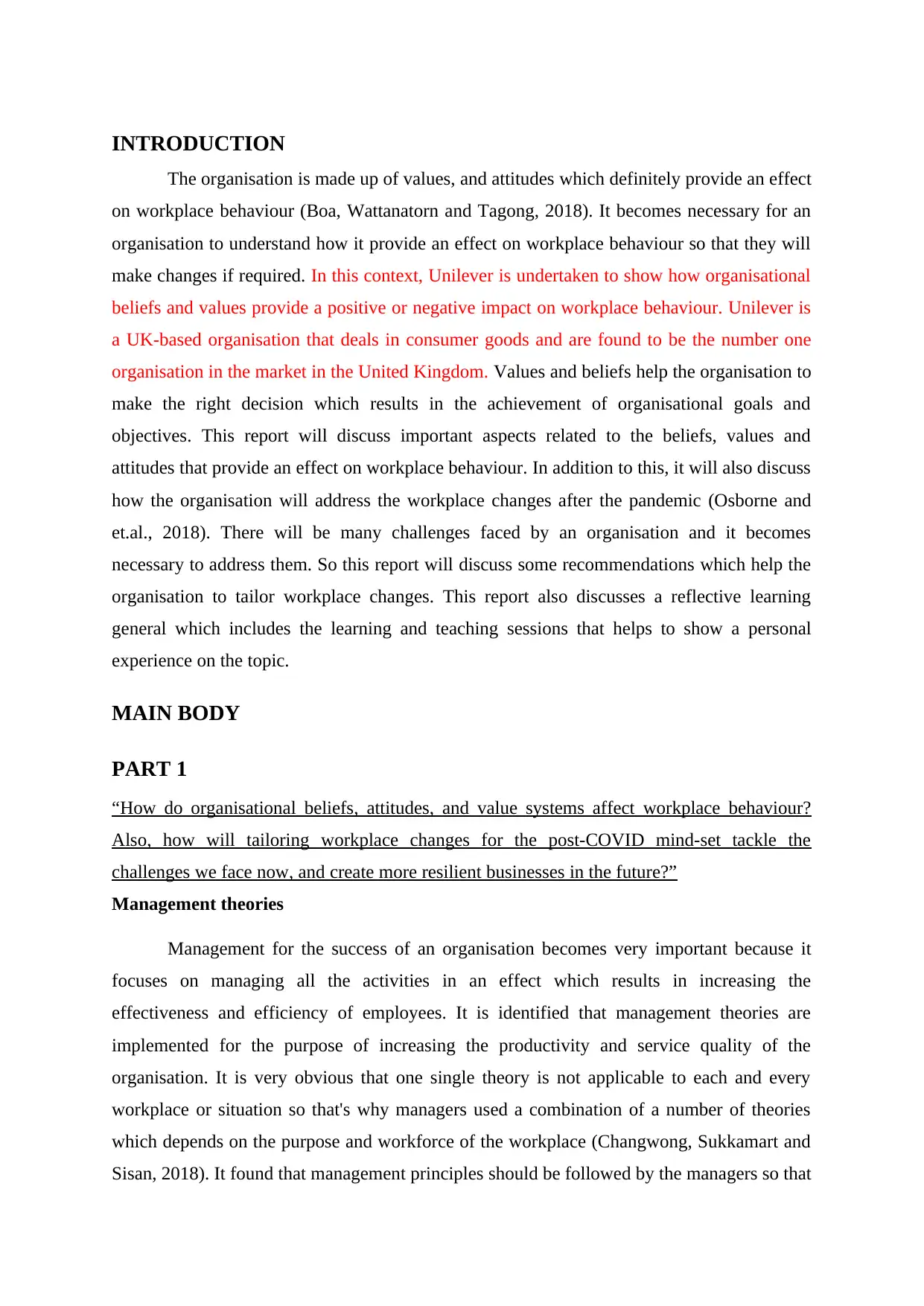
INTRODUCTION
The organisation is made up of values, and attitudes which definitely provide an effect
on workplace behaviour (Boa, Wattanatorn and Tagong, 2018). It becomes necessary for an
organisation to understand how it provide an effect on workplace behaviour so that they will
make changes if required. In this context, Unilever is undertaken to show how organisational
beliefs and values provide a positive or negative impact on workplace behaviour. Unilever is
a UK-based organisation that deals in consumer goods and are found to be the number one
organisation in the market in the United Kingdom. Values and beliefs help the organisation to
make the right decision which results in the achievement of organisational goals and
objectives. This report will discuss important aspects related to the beliefs, values and
attitudes that provide an effect on workplace behaviour. In addition to this, it will also discuss
how the organisation will address the workplace changes after the pandemic (Osborne and
et.al., 2018). There will be many challenges faced by an organisation and it becomes
necessary to address them. So this report will discuss some recommendations which help the
organisation to tailor workplace changes. This report also discusses a reflective learning
general which includes the learning and teaching sessions that helps to show a personal
experience on the topic.
MAIN BODY
PART 1
“How do organisational beliefs, attitudes, and value systems affect workplace behaviour?
Also, how will tailoring workplace changes for the post-COVID mind-set tackle the
challenges we face now, and create more resilient businesses in the future?”
Management theories
Management for the success of an organisation becomes very important because it
focuses on managing all the activities in an effect which results in increasing the
effectiveness and efficiency of employees. It is identified that management theories are
implemented for the purpose of increasing the productivity and service quality of the
organisation. It is very obvious that one single theory is not applicable to each and every
workplace or situation so that's why managers used a combination of a number of theories
which depends on the purpose and workforce of the workplace (Changwong, Sukkamart and
Sisan, 2018). It found that management principles should be followed by the managers so that
The organisation is made up of values, and attitudes which definitely provide an effect
on workplace behaviour (Boa, Wattanatorn and Tagong, 2018). It becomes necessary for an
organisation to understand how it provide an effect on workplace behaviour so that they will
make changes if required. In this context, Unilever is undertaken to show how organisational
beliefs and values provide a positive or negative impact on workplace behaviour. Unilever is
a UK-based organisation that deals in consumer goods and are found to be the number one
organisation in the market in the United Kingdom. Values and beliefs help the organisation to
make the right decision which results in the achievement of organisational goals and
objectives. This report will discuss important aspects related to the beliefs, values and
attitudes that provide an effect on workplace behaviour. In addition to this, it will also discuss
how the organisation will address the workplace changes after the pandemic (Osborne and
et.al., 2018). There will be many challenges faced by an organisation and it becomes
necessary to address them. So this report will discuss some recommendations which help the
organisation to tailor workplace changes. This report also discusses a reflective learning
general which includes the learning and teaching sessions that helps to show a personal
experience on the topic.
MAIN BODY
PART 1
“How do organisational beliefs, attitudes, and value systems affect workplace behaviour?
Also, how will tailoring workplace changes for the post-COVID mind-set tackle the
challenges we face now, and create more resilient businesses in the future?”
Management theories
Management for the success of an organisation becomes very important because it
focuses on managing all the activities in an effect which results in increasing the
effectiveness and efficiency of employees. It is identified that management theories are
implemented for the purpose of increasing the productivity and service quality of the
organisation. It is very obvious that one single theory is not applicable to each and every
workplace or situation so that's why managers used a combination of a number of theories
which depends on the purpose and workforce of the workplace (Changwong, Sukkamart and
Sisan, 2018). It found that management principles should be followed by the managers so that
⊘ This is a preview!⊘
Do you want full access?
Subscribe today to unlock all pages.

Trusted by 1+ million students worldwide
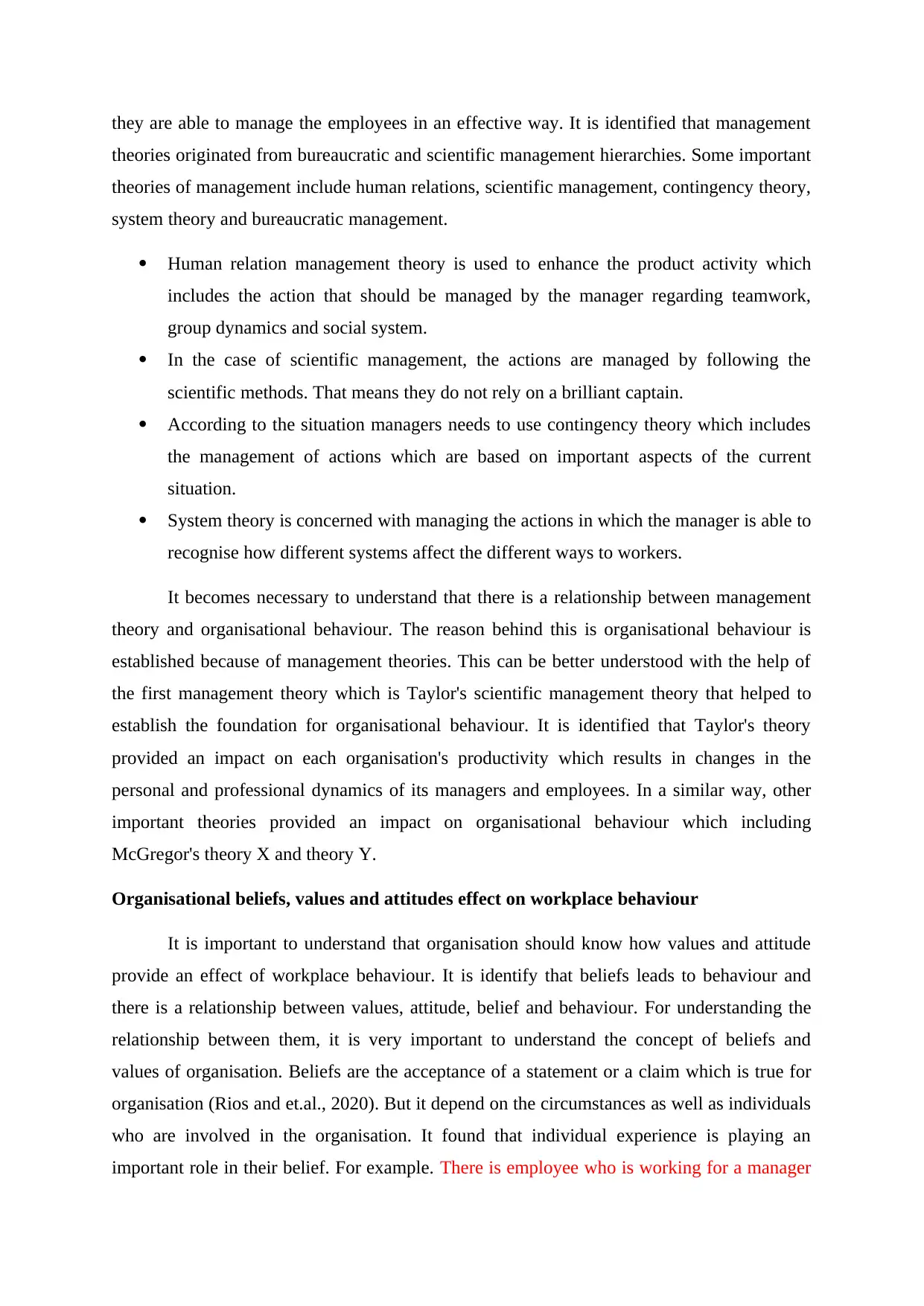
they are able to manage the employees in an effective way. It is identified that management
theories originated from bureaucratic and scientific management hierarchies. Some important
theories of management include human relations, scientific management, contingency theory,
system theory and bureaucratic management.
Human relation management theory is used to enhance the product activity which
includes the action that should be managed by the manager regarding teamwork,
group dynamics and social system.
In the case of scientific management, the actions are managed by following the
scientific methods. That means they do not rely on a brilliant captain.
According to the situation managers needs to use contingency theory which includes
the management of actions which are based on important aspects of the current
situation.
System theory is concerned with managing the actions in which the manager is able to
recognise how different systems affect the different ways to workers.
It becomes necessary to understand that there is a relationship between management
theory and organisational behaviour. The reason behind this is organisational behaviour is
established because of management theories. This can be better understood with the help of
the first management theory which is Taylor's scientific management theory that helped to
establish the foundation for organisational behaviour. It is identified that Taylor's theory
provided an impact on each organisation's productivity which results in changes in the
personal and professional dynamics of its managers and employees. In a similar way, other
important theories provided an impact on organisational behaviour which including
McGregor's theory X and theory Y.
Organisational beliefs, values and attitudes effect on workplace behaviour
It is important to understand that organisation should know how values and attitude
provide an effect of workplace behaviour. It is identify that beliefs leads to behaviour and
there is a relationship between values, attitude, belief and behaviour. For understanding the
relationship between them, it is very important to understand the concept of beliefs and
values of organisation. Beliefs are the acceptance of a statement or a claim which is true for
organisation (Rios and et.al., 2020). But it depend on the circumstances as well as individuals
who are involved in the organisation. It found that individual experience is playing an
important role in their belief. For example. There is employee who is working for a manager
theories originated from bureaucratic and scientific management hierarchies. Some important
theories of management include human relations, scientific management, contingency theory,
system theory and bureaucratic management.
Human relation management theory is used to enhance the product activity which
includes the action that should be managed by the manager regarding teamwork,
group dynamics and social system.
In the case of scientific management, the actions are managed by following the
scientific methods. That means they do not rely on a brilliant captain.
According to the situation managers needs to use contingency theory which includes
the management of actions which are based on important aspects of the current
situation.
System theory is concerned with managing the actions in which the manager is able to
recognise how different systems affect the different ways to workers.
It becomes necessary to understand that there is a relationship between management
theory and organisational behaviour. The reason behind this is organisational behaviour is
established because of management theories. This can be better understood with the help of
the first management theory which is Taylor's scientific management theory that helped to
establish the foundation for organisational behaviour. It is identified that Taylor's theory
provided an impact on each organisation's productivity which results in changes in the
personal and professional dynamics of its managers and employees. In a similar way, other
important theories provided an impact on organisational behaviour which including
McGregor's theory X and theory Y.
Organisational beliefs, values and attitudes effect on workplace behaviour
It is important to understand that organisation should know how values and attitude
provide an effect of workplace behaviour. It is identify that beliefs leads to behaviour and
there is a relationship between values, attitude, belief and behaviour. For understanding the
relationship between them, it is very important to understand the concept of beliefs and
values of organisation. Beliefs are the acceptance of a statement or a claim which is true for
organisation (Rios and et.al., 2020). But it depend on the circumstances as well as individuals
who are involved in the organisation. It found that individual experience is playing an
important role in their belief. For example. There is employee who is working for a manager
Paraphrase This Document
Need a fresh take? Get an instant paraphrase of this document with our AI Paraphraser
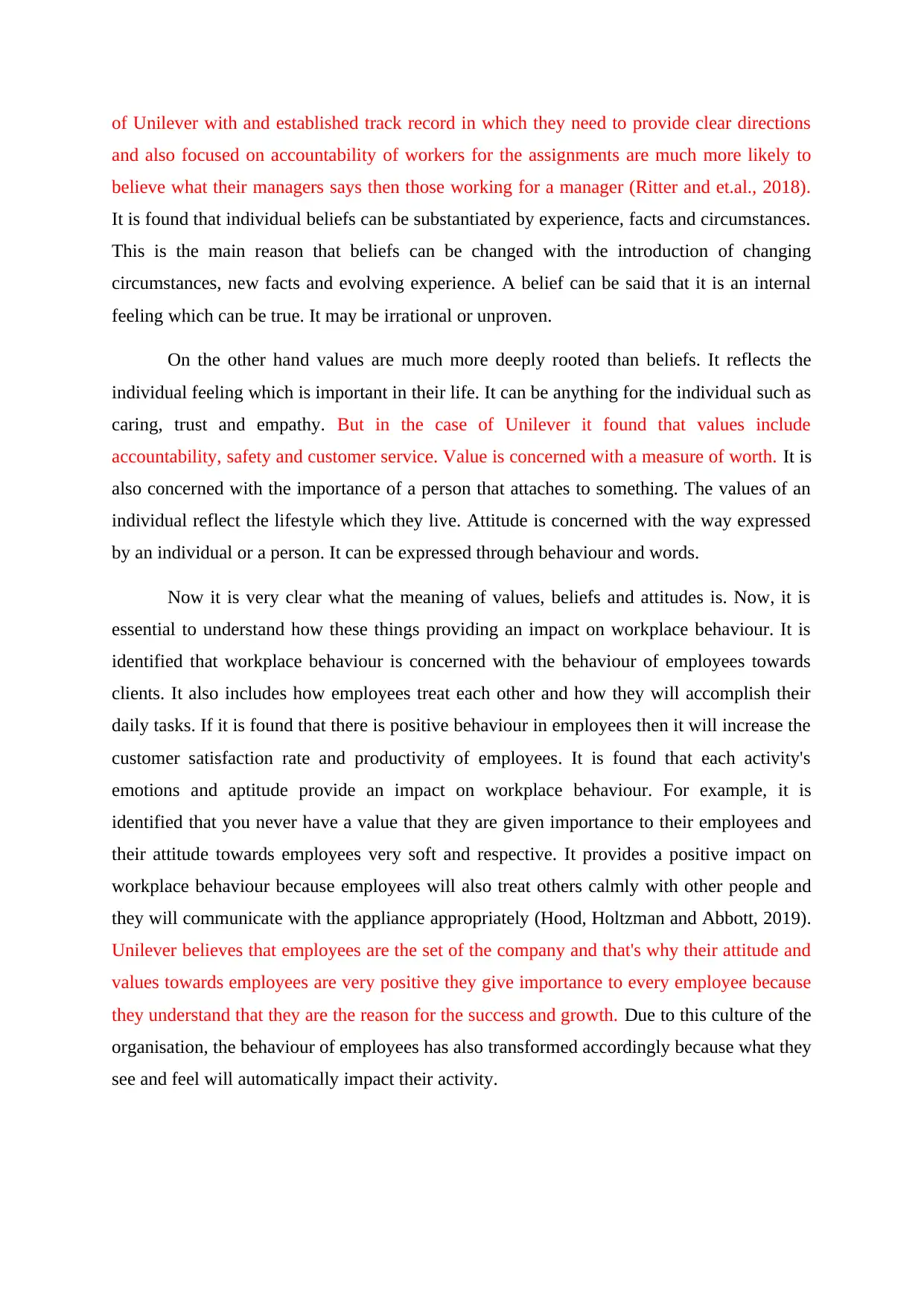
of Unilever with and established track record in which they need to provide clear directions
and also focused on accountability of workers for the assignments are much more likely to
believe what their managers says then those working for a manager (Ritter and et.al., 2018).
It is found that individual beliefs can be substantiated by experience, facts and circumstances.
This is the main reason that beliefs can be changed with the introduction of changing
circumstances, new facts and evolving experience. A belief can be said that it is an internal
feeling which can be true. It may be irrational or unproven.
On the other hand values are much more deeply rooted than beliefs. It reflects the
individual feeling which is important in their life. It can be anything for the individual such as
caring, trust and empathy. But in the case of Unilever it found that values include
accountability, safety and customer service. Value is concerned with a measure of worth. It is
also concerned with the importance of a person that attaches to something. The values of an
individual reflect the lifestyle which they live. Attitude is concerned with the way expressed
by an individual or a person. It can be expressed through behaviour and words.
Now it is very clear what the meaning of values, beliefs and attitudes is. Now, it is
essential to understand how these things providing an impact on workplace behaviour. It is
identified that workplace behaviour is concerned with the behaviour of employees towards
clients. It also includes how employees treat each other and how they will accomplish their
daily tasks. If it is found that there is positive behaviour in employees then it will increase the
customer satisfaction rate and productivity of employees. It is found that each activity's
emotions and aptitude provide an impact on workplace behaviour. For example, it is
identified that you never have a value that they are given importance to their employees and
their attitude towards employees very soft and respective. It provides a positive impact on
workplace behaviour because employees will also treat others calmly with other people and
they will communicate with the appliance appropriately (Hood, Holtzman and Abbott, 2019).
Unilever believes that employees are the set of the company and that's why their attitude and
values towards employees are very positive they give importance to every employee because
they understand that they are the reason for the success and growth. Due to this culture of the
organisation, the behaviour of employees has also transformed accordingly because what they
see and feel will automatically impact their activity.
and also focused on accountability of workers for the assignments are much more likely to
believe what their managers says then those working for a manager (Ritter and et.al., 2018).
It is found that individual beliefs can be substantiated by experience, facts and circumstances.
This is the main reason that beliefs can be changed with the introduction of changing
circumstances, new facts and evolving experience. A belief can be said that it is an internal
feeling which can be true. It may be irrational or unproven.
On the other hand values are much more deeply rooted than beliefs. It reflects the
individual feeling which is important in their life. It can be anything for the individual such as
caring, trust and empathy. But in the case of Unilever it found that values include
accountability, safety and customer service. Value is concerned with a measure of worth. It is
also concerned with the importance of a person that attaches to something. The values of an
individual reflect the lifestyle which they live. Attitude is concerned with the way expressed
by an individual or a person. It can be expressed through behaviour and words.
Now it is very clear what the meaning of values, beliefs and attitudes is. Now, it is
essential to understand how these things providing an impact on workplace behaviour. It is
identified that workplace behaviour is concerned with the behaviour of employees towards
clients. It also includes how employees treat each other and how they will accomplish their
daily tasks. If it is found that there is positive behaviour in employees then it will increase the
customer satisfaction rate and productivity of employees. It is found that each activity's
emotions and aptitude provide an impact on workplace behaviour. For example, it is
identified that you never have a value that they are given importance to their employees and
their attitude towards employees very soft and respective. It provides a positive impact on
workplace behaviour because employees will also treat others calmly with other people and
they will communicate with the appliance appropriately (Hood, Holtzman and Abbott, 2019).
Unilever believes that employees are the set of the company and that's why their attitude and
values towards employees are very positive they give importance to every employee because
they understand that they are the reason for the success and growth. Due to this culture of the
organisation, the behaviour of employees has also transformed accordingly because what they
see and feel will automatically impact their activity.
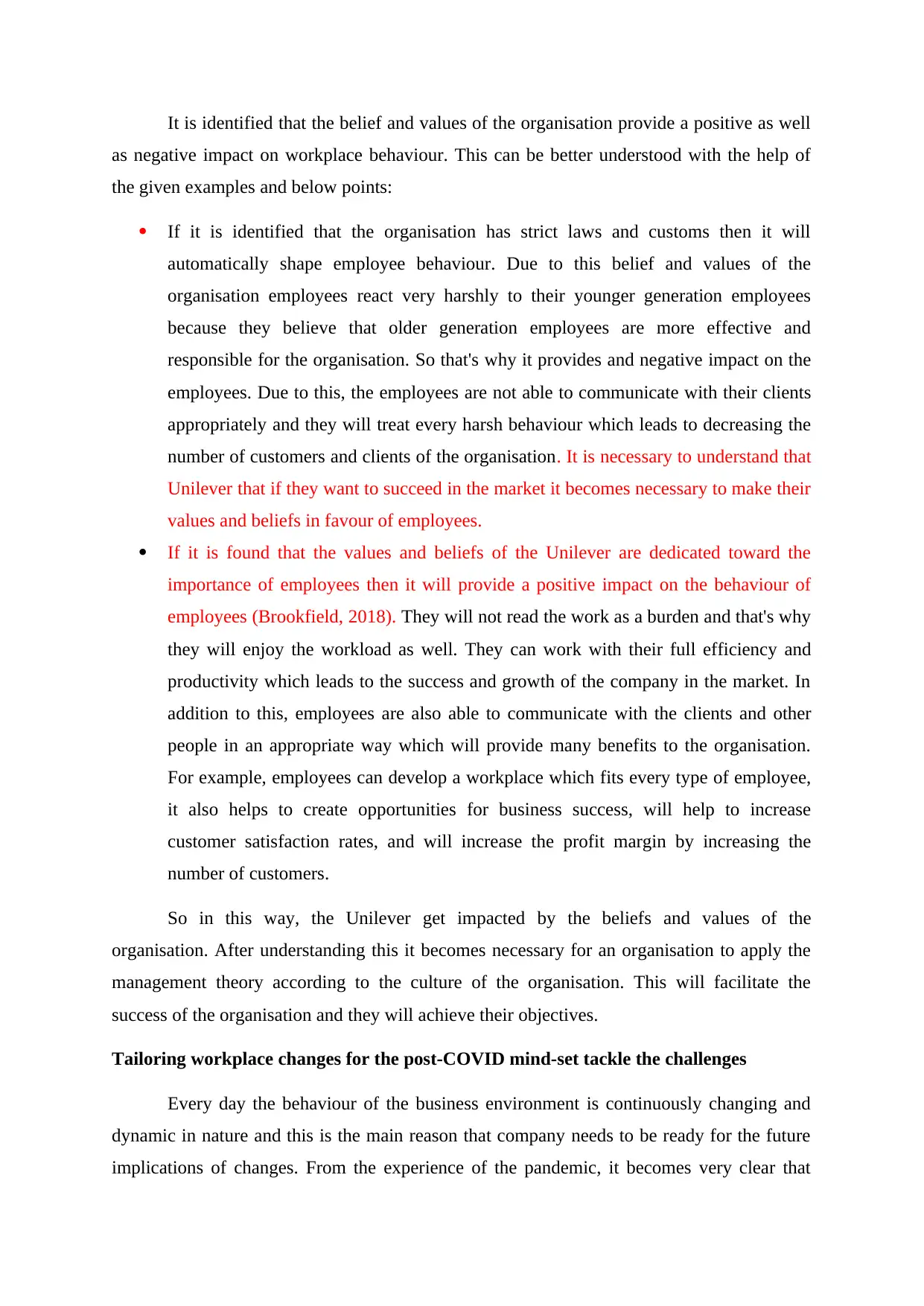
It is identified that the belief and values of the organisation provide a positive as well
as negative impact on workplace behaviour. This can be better understood with the help of
the given examples and below points:
If it is identified that the organisation has strict laws and customs then it will
automatically shape employee behaviour. Due to this belief and values of the
organisation employees react very harshly to their younger generation employees
because they believe that older generation employees are more effective and
responsible for the organisation. So that's why it provides and negative impact on the
employees. Due to this, the employees are not able to communicate with their clients
appropriately and they will treat every harsh behaviour which leads to decreasing the
number of customers and clients of the organisation. It is necessary to understand that
Unilever that if they want to succeed in the market it becomes necessary to make their
values and beliefs in favour of employees.
If it is found that the values and beliefs of the Unilever are dedicated toward the
importance of employees then it will provide a positive impact on the behaviour of
employees (Brookfield, 2018). They will not read the work as a burden and that's why
they will enjoy the workload as well. They can work with their full efficiency and
productivity which leads to the success and growth of the company in the market. In
addition to this, employees are also able to communicate with the clients and other
people in an appropriate way which will provide many benefits to the organisation.
For example, employees can develop a workplace which fits every type of employee,
it also helps to create opportunities for business success, will help to increase
customer satisfaction rates, and will increase the profit margin by increasing the
number of customers.
So in this way, the Unilever get impacted by the beliefs and values of the
organisation. After understanding this it becomes necessary for an organisation to apply the
management theory according to the culture of the organisation. This will facilitate the
success of the organisation and they will achieve their objectives.
Tailoring workplace changes for the post-COVID mind-set tackle the challenges
Every day the behaviour of the business environment is continuously changing and
dynamic in nature and this is the main reason that company needs to be ready for the future
implications of changes. From the experience of the pandemic, it becomes very clear that
as negative impact on workplace behaviour. This can be better understood with the help of
the given examples and below points:
If it is identified that the organisation has strict laws and customs then it will
automatically shape employee behaviour. Due to this belief and values of the
organisation employees react very harshly to their younger generation employees
because they believe that older generation employees are more effective and
responsible for the organisation. So that's why it provides and negative impact on the
employees. Due to this, the employees are not able to communicate with their clients
appropriately and they will treat every harsh behaviour which leads to decreasing the
number of customers and clients of the organisation. It is necessary to understand that
Unilever that if they want to succeed in the market it becomes necessary to make their
values and beliefs in favour of employees.
If it is found that the values and beliefs of the Unilever are dedicated toward the
importance of employees then it will provide a positive impact on the behaviour of
employees (Brookfield, 2018). They will not read the work as a burden and that's why
they will enjoy the workload as well. They can work with their full efficiency and
productivity which leads to the success and growth of the company in the market. In
addition to this, employees are also able to communicate with the clients and other
people in an appropriate way which will provide many benefits to the organisation.
For example, employees can develop a workplace which fits every type of employee,
it also helps to create opportunities for business success, will help to increase
customer satisfaction rates, and will increase the profit margin by increasing the
number of customers.
So in this way, the Unilever get impacted by the beliefs and values of the
organisation. After understanding this it becomes necessary for an organisation to apply the
management theory according to the culture of the organisation. This will facilitate the
success of the organisation and they will achieve their objectives.
Tailoring workplace changes for the post-COVID mind-set tackle the challenges
Every day the behaviour of the business environment is continuously changing and
dynamic in nature and this is the main reason that company needs to be ready for the future
implications of changes. From the experience of the pandemic, it becomes very clear that
⊘ This is a preview!⊘
Do you want full access?
Subscribe today to unlock all pages.

Trusted by 1+ million students worldwide
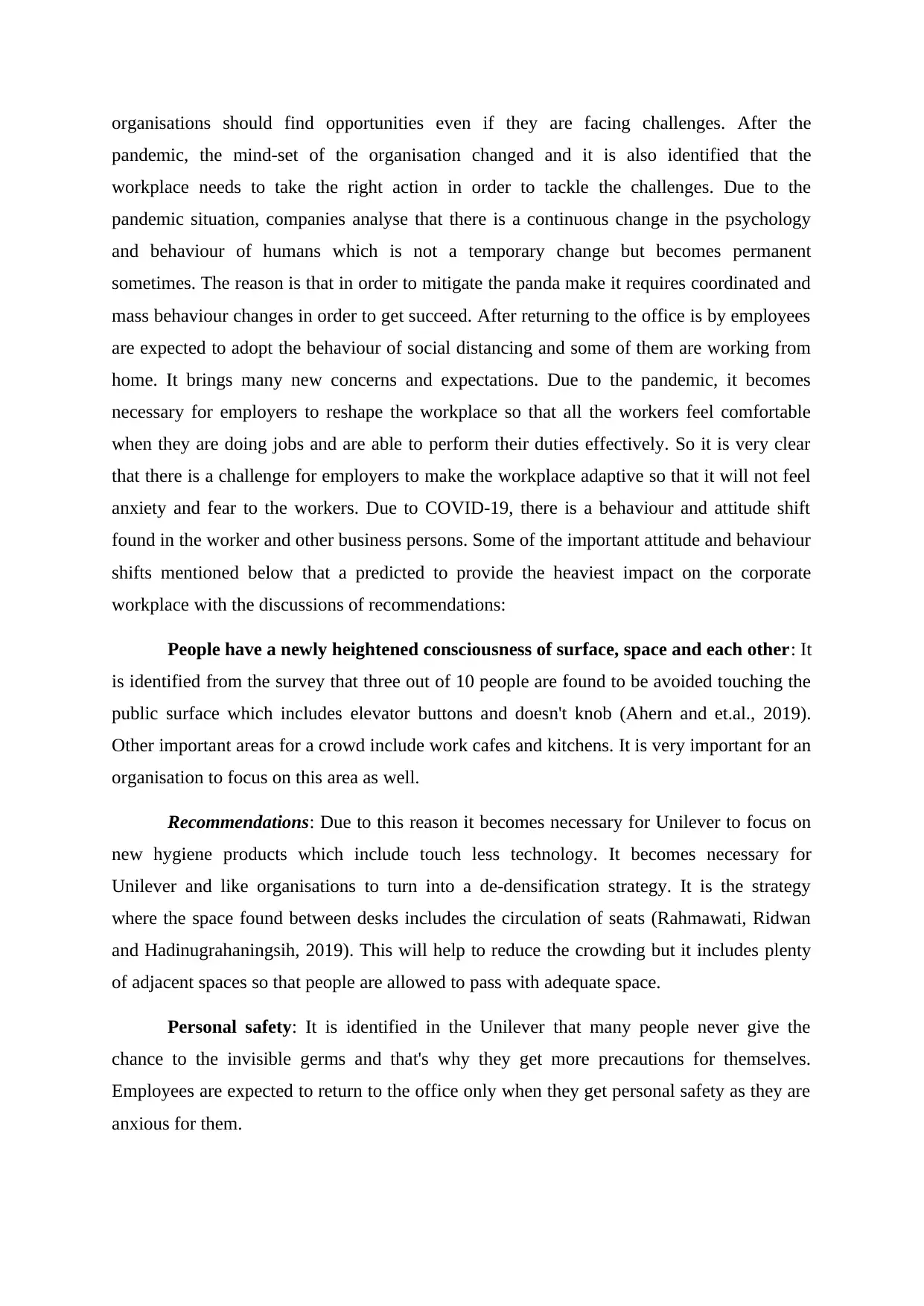
organisations should find opportunities even if they are facing challenges. After the
pandemic, the mind-set of the organisation changed and it is also identified that the
workplace needs to take the right action in order to tackle the challenges. Due to the
pandemic situation, companies analyse that there is a continuous change in the psychology
and behaviour of humans which is not a temporary change but becomes permanent
sometimes. The reason is that in order to mitigate the panda make it requires coordinated and
mass behaviour changes in order to get succeed. After returning to the office is by employees
are expected to adopt the behaviour of social distancing and some of them are working from
home. It brings many new concerns and expectations. Due to the pandemic, it becomes
necessary for employers to reshape the workplace so that all the workers feel comfortable
when they are doing jobs and are able to perform their duties effectively. So it is very clear
that there is a challenge for employers to make the workplace adaptive so that it will not feel
anxiety and fear to the workers. Due to COVID-19, there is a behaviour and attitude shift
found in the worker and other business persons. Some of the important attitude and behaviour
shifts mentioned below that a predicted to provide the heaviest impact on the corporate
workplace with the discussions of recommendations:
People have a newly heightened consciousness of surface, space and each other: It
is identified from the survey that three out of 10 people are found to be avoided touching the
public surface which includes elevator buttons and doesn't knob (Ahern and et.al., 2019).
Other important areas for a crowd include work cafes and kitchens. It is very important for an
organisation to focus on this area as well.
Recommendations: Due to this reason it becomes necessary for Unilever to focus on
new hygiene products which include touch less technology. It becomes necessary for
Unilever and like organisations to turn into a de-densification strategy. It is the strategy
where the space found between desks includes the circulation of seats (Rahmawati, Ridwan
and Hadinugrahaningsih, 2019). This will help to reduce the crowding but it includes plenty
of adjacent spaces so that people are allowed to pass with adequate space.
Personal safety: It is identified in the Unilever that many people never give the
chance to the invisible germs and that's why they get more precautions for themselves.
Employees are expected to return to the office only when they get personal safety as they are
anxious for them.
pandemic, the mind-set of the organisation changed and it is also identified that the
workplace needs to take the right action in order to tackle the challenges. Due to the
pandemic situation, companies analyse that there is a continuous change in the psychology
and behaviour of humans which is not a temporary change but becomes permanent
sometimes. The reason is that in order to mitigate the panda make it requires coordinated and
mass behaviour changes in order to get succeed. After returning to the office is by employees
are expected to adopt the behaviour of social distancing and some of them are working from
home. It brings many new concerns and expectations. Due to the pandemic, it becomes
necessary for employers to reshape the workplace so that all the workers feel comfortable
when they are doing jobs and are able to perform their duties effectively. So it is very clear
that there is a challenge for employers to make the workplace adaptive so that it will not feel
anxiety and fear to the workers. Due to COVID-19, there is a behaviour and attitude shift
found in the worker and other business persons. Some of the important attitude and behaviour
shifts mentioned below that a predicted to provide the heaviest impact on the corporate
workplace with the discussions of recommendations:
People have a newly heightened consciousness of surface, space and each other: It
is identified from the survey that three out of 10 people are found to be avoided touching the
public surface which includes elevator buttons and doesn't knob (Ahern and et.al., 2019).
Other important areas for a crowd include work cafes and kitchens. It is very important for an
organisation to focus on this area as well.
Recommendations: Due to this reason it becomes necessary for Unilever to focus on
new hygiene products which include touch less technology. It becomes necessary for
Unilever and like organisations to turn into a de-densification strategy. It is the strategy
where the space found between desks includes the circulation of seats (Rahmawati, Ridwan
and Hadinugrahaningsih, 2019). This will help to reduce the crowding but it includes plenty
of adjacent spaces so that people are allowed to pass with adequate space.
Personal safety: It is identified in the Unilever that many people never give the
chance to the invisible germs and that's why they get more precautions for themselves.
Employees are expected to return to the office only when they get personal safety as they are
anxious for them.
Paraphrase This Document
Need a fresh take? Get an instant paraphrase of this document with our AI Paraphraser
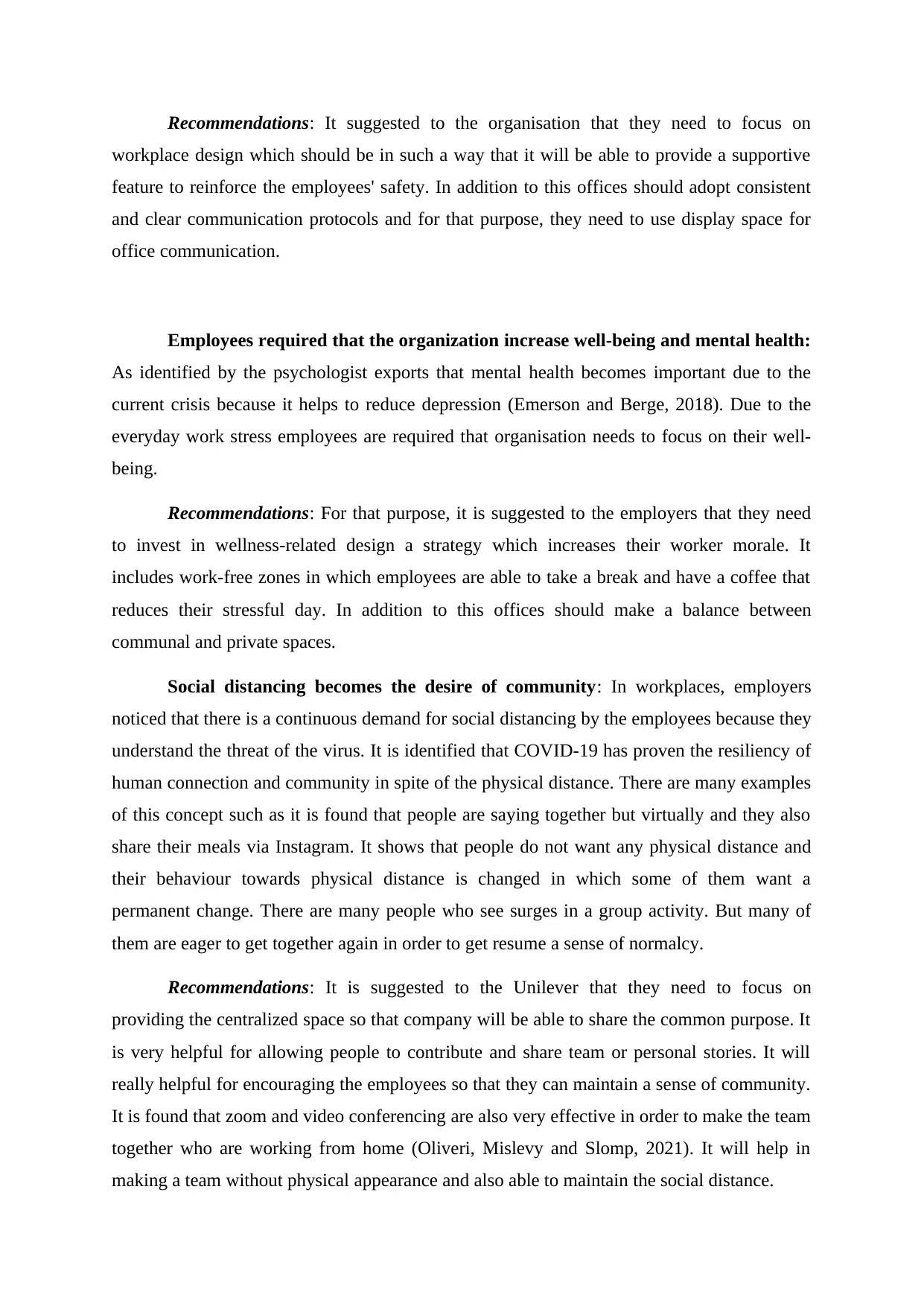
Recommendations: It suggested to the organisation that they need to focus on
workplace design which should be in such a way that it will be able to provide a supportive
feature to reinforce the employees' safety. In addition to this offices should adopt consistent
and clear communication protocols and for that purpose, they need to use display space for
office communication.
Employees required that the organization increase well-being and mental health:
As identified by the psychologist exports that mental health becomes important due to the
current crisis because it helps to reduce depression (Emerson and Berge, 2018). Due to the
everyday work stress employees are required that organisation needs to focus on their well-
being.
Recommendations: For that purpose, it is suggested to the employers that they need
to invest in wellness-related design a strategy which increases their worker morale. It
includes work-free zones in which employees are able to take a break and have a coffee that
reduces their stressful day. In addition to this offices should make a balance between
communal and private spaces.
Social distancing becomes the desire of community: In workplaces, employers
noticed that there is a continuous demand for social distancing by the employees because they
understand the threat of the virus. It is identified that COVID-19 has proven the resiliency of
human connection and community in spite of the physical distance. There are many examples
of this concept such as it is found that people are saying together but virtually and they also
share their meals via Instagram. It shows that people do not want any physical distance and
their behaviour towards physical distance is changed in which some of them want a
permanent change. There are many people who see surges in a group activity. But many of
them are eager to get together again in order to get resume a sense of normalcy.
Recommendations: It is suggested to the Unilever that they need to focus on
providing the centralized space so that company will be able to share the common purpose. It
is very helpful for allowing people to contribute and share team or personal stories. It will
really helpful for encouraging the employees so that they can maintain a sense of community.
It is found that zoom and video conferencing are also very effective in order to make the team
together who are working from home (Oliveri, Mislevy and Slomp, 2021). It will help in
making a team without physical appearance and also able to maintain the social distance.
workplace design which should be in such a way that it will be able to provide a supportive
feature to reinforce the employees' safety. In addition to this offices should adopt consistent
and clear communication protocols and for that purpose, they need to use display space for
office communication.
Employees required that the organization increase well-being and mental health:
As identified by the psychologist exports that mental health becomes important due to the
current crisis because it helps to reduce depression (Emerson and Berge, 2018). Due to the
everyday work stress employees are required that organisation needs to focus on their well-
being.
Recommendations: For that purpose, it is suggested to the employers that they need
to invest in wellness-related design a strategy which increases their worker morale. It
includes work-free zones in which employees are able to take a break and have a coffee that
reduces their stressful day. In addition to this offices should make a balance between
communal and private spaces.
Social distancing becomes the desire of community: In workplaces, employers
noticed that there is a continuous demand for social distancing by the employees because they
understand the threat of the virus. It is identified that COVID-19 has proven the resiliency of
human connection and community in spite of the physical distance. There are many examples
of this concept such as it is found that people are saying together but virtually and they also
share their meals via Instagram. It shows that people do not want any physical distance and
their behaviour towards physical distance is changed in which some of them want a
permanent change. There are many people who see surges in a group activity. But many of
them are eager to get together again in order to get resume a sense of normalcy.
Recommendations: It is suggested to the Unilever that they need to focus on
providing the centralized space so that company will be able to share the common purpose. It
is very helpful for allowing people to contribute and share team or personal stories. It will
really helpful for encouraging the employees so that they can maintain a sense of community.
It is found that zoom and video conferencing are also very effective in order to make the team
together who are working from home (Oliveri, Mislevy and Slomp, 2021). It will help in
making a team without physical appearance and also able to maintain the social distance.
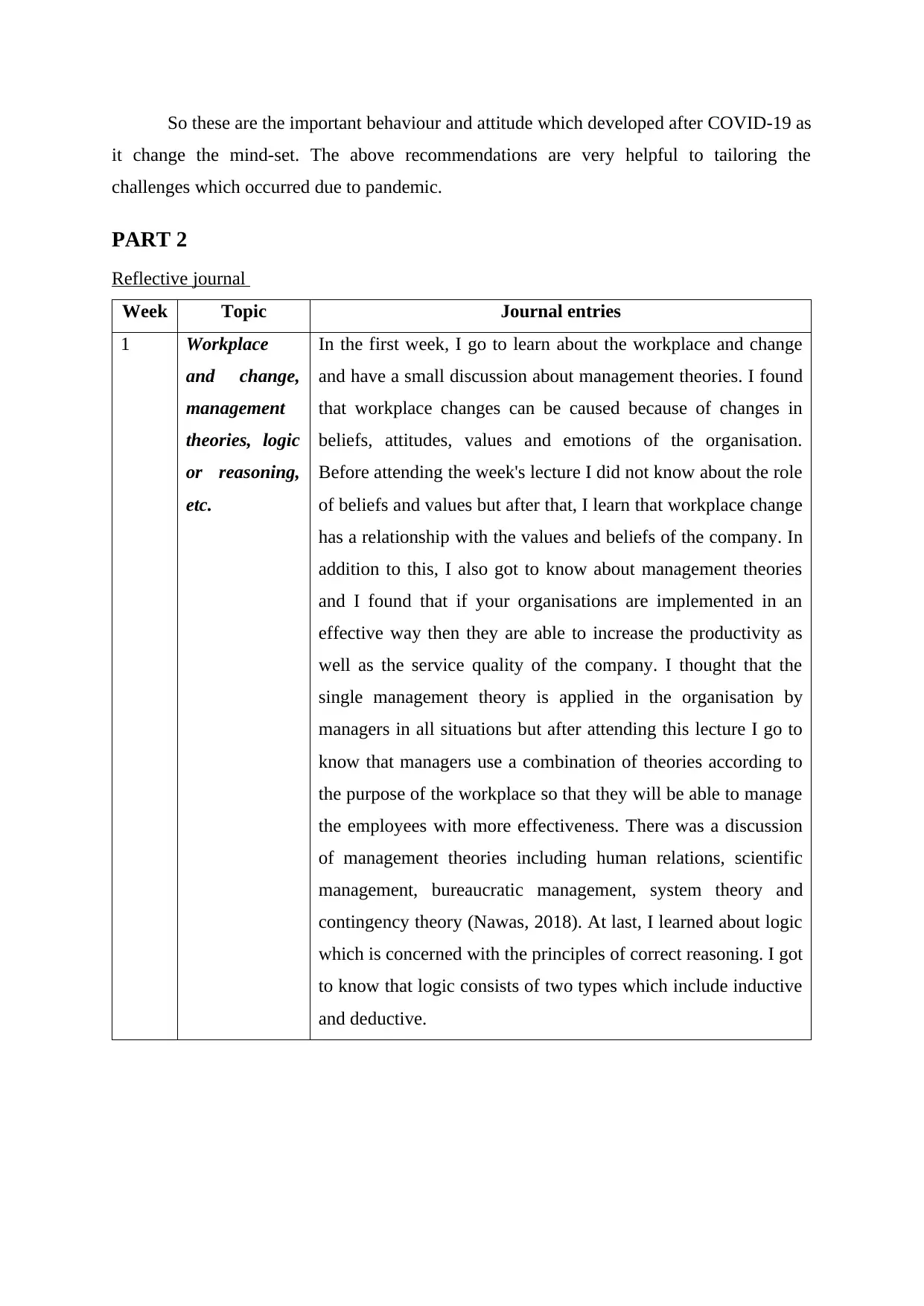
So these are the important behaviour and attitude which developed after COVID-19 as
it change the mind-set. The above recommendations are very helpful to tailoring the
challenges which occurred due to pandemic.
PART 2
Reflective journal
Week Topic Journal entries
1 Workplace
and change,
management
theories, logic
or reasoning,
etc.
In the first week, I go to learn about the workplace and change
and have a small discussion about management theories. I found
that workplace changes can be caused because of changes in
beliefs, attitudes, values and emotions of the organisation.
Before attending the week's lecture I did not know about the role
of beliefs and values but after that, I learn that workplace change
has a relationship with the values and beliefs of the company. In
addition to this, I also got to know about management theories
and I found that if your organisations are implemented in an
effective way then they are able to increase the productivity as
well as the service quality of the company. I thought that the
single management theory is applied in the organisation by
managers in all situations but after attending this lecture I go to
know that managers use a combination of theories according to
the purpose of the workplace so that they will be able to manage
the employees with more effectiveness. There was a discussion
of management theories including human relations, scientific
management, bureaucratic management, system theory and
contingency theory (Nawas, 2018). At last, I learned about logic
which is concerned with the principles of correct reasoning. I got
to know that logic consists of two types which include inductive
and deductive.
it change the mind-set. The above recommendations are very helpful to tailoring the
challenges which occurred due to pandemic.
PART 2
Reflective journal
Week Topic Journal entries
1 Workplace
and change,
management
theories, logic
or reasoning,
etc.
In the first week, I go to learn about the workplace and change
and have a small discussion about management theories. I found
that workplace changes can be caused because of changes in
beliefs, attitudes, values and emotions of the organisation.
Before attending the week's lecture I did not know about the role
of beliefs and values but after that, I learn that workplace change
has a relationship with the values and beliefs of the company. In
addition to this, I also got to know about management theories
and I found that if your organisations are implemented in an
effective way then they are able to increase the productivity as
well as the service quality of the company. I thought that the
single management theory is applied in the organisation by
managers in all situations but after attending this lecture I go to
know that managers use a combination of theories according to
the purpose of the workplace so that they will be able to manage
the employees with more effectiveness. There was a discussion
of management theories including human relations, scientific
management, bureaucratic management, system theory and
contingency theory (Nawas, 2018). At last, I learned about logic
which is concerned with the principles of correct reasoning. I got
to know that logic consists of two types which include inductive
and deductive.
⊘ This is a preview!⊘
Do you want full access?
Subscribe today to unlock all pages.

Trusted by 1+ million students worldwide
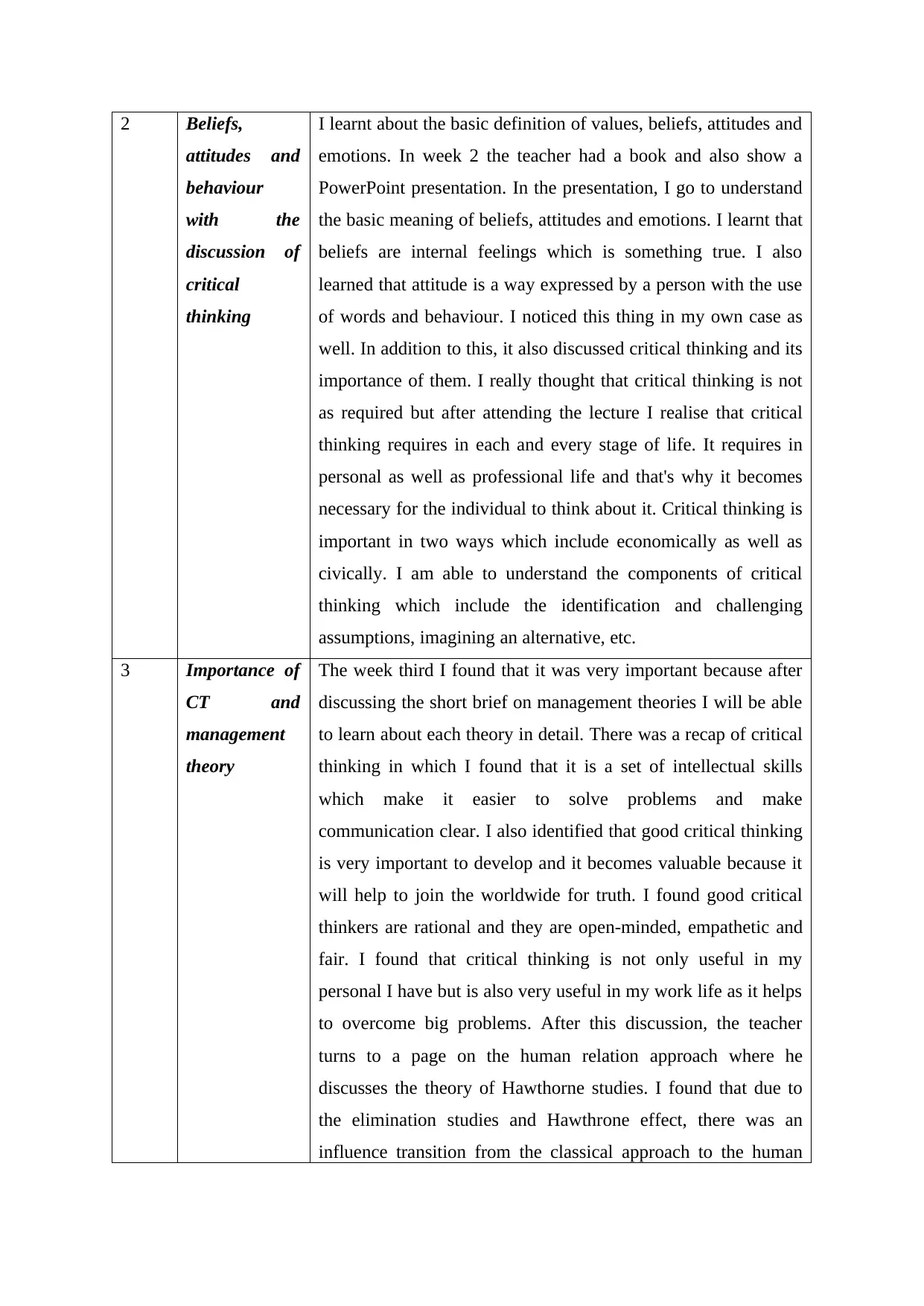
2 Beliefs,
attitudes and
behaviour
with the
discussion of
critical
thinking
I learnt about the basic definition of values, beliefs, attitudes and
emotions. In week 2 the teacher had a book and also show a
PowerPoint presentation. In the presentation, I go to understand
the basic meaning of beliefs, attitudes and emotions. I learnt that
beliefs are internal feelings which is something true. I also
learned that attitude is a way expressed by a person with the use
of words and behaviour. I noticed this thing in my own case as
well. In addition to this, it also discussed critical thinking and its
importance of them. I really thought that critical thinking is not
as required but after attending the lecture I realise that critical
thinking requires in each and every stage of life. It requires in
personal as well as professional life and that's why it becomes
necessary for the individual to think about it. Critical thinking is
important in two ways which include economically as well as
civically. I am able to understand the components of critical
thinking which include the identification and challenging
assumptions, imagining an alternative, etc.
3 Importance of
CT and
management
theory
The week third I found that it was very important because after
discussing the short brief on management theories I will be able
to learn about each theory in detail. There was a recap of critical
thinking in which I found that it is a set of intellectual skills
which make it easier to solve problems and make
communication clear. I also identified that good critical thinking
is very important to develop and it becomes valuable because it
will help to join the worldwide for truth. I found good critical
thinkers are rational and they are open-minded, empathetic and
fair. I found that critical thinking is not only useful in my
personal I have but is also very useful in my work life as it helps
to overcome big problems. After this discussion, the teacher
turns to a page on the human relation approach where he
discusses the theory of Hawthorne studies. I found that due to
the elimination studies and Hawthrone effect, there was an
influence transition from the classical approach to the human
attitudes and
behaviour
with the
discussion of
critical
thinking
I learnt about the basic definition of values, beliefs, attitudes and
emotions. In week 2 the teacher had a book and also show a
PowerPoint presentation. In the presentation, I go to understand
the basic meaning of beliefs, attitudes and emotions. I learnt that
beliefs are internal feelings which is something true. I also
learned that attitude is a way expressed by a person with the use
of words and behaviour. I noticed this thing in my own case as
well. In addition to this, it also discussed critical thinking and its
importance of them. I really thought that critical thinking is not
as required but after attending the lecture I realise that critical
thinking requires in each and every stage of life. It requires in
personal as well as professional life and that's why it becomes
necessary for the individual to think about it. Critical thinking is
important in two ways which include economically as well as
civically. I am able to understand the components of critical
thinking which include the identification and challenging
assumptions, imagining an alternative, etc.
3 Importance of
CT and
management
theory
The week third I found that it was very important because after
discussing the short brief on management theories I will be able
to learn about each theory in detail. There was a recap of critical
thinking in which I found that it is a set of intellectual skills
which make it easier to solve problems and make
communication clear. I also identified that good critical thinking
is very important to develop and it becomes valuable because it
will help to join the worldwide for truth. I found good critical
thinkers are rational and they are open-minded, empathetic and
fair. I found that critical thinking is not only useful in my
personal I have but is also very useful in my work life as it helps
to overcome big problems. After this discussion, the teacher
turns to a page on the human relation approach where he
discusses the theory of Hawthorne studies. I found that due to
the elimination studies and Hawthrone effect, there was an
influence transition from the classical approach to the human
Paraphrase This Document
Need a fresh take? Get an instant paraphrase of this document with our AI Paraphraser
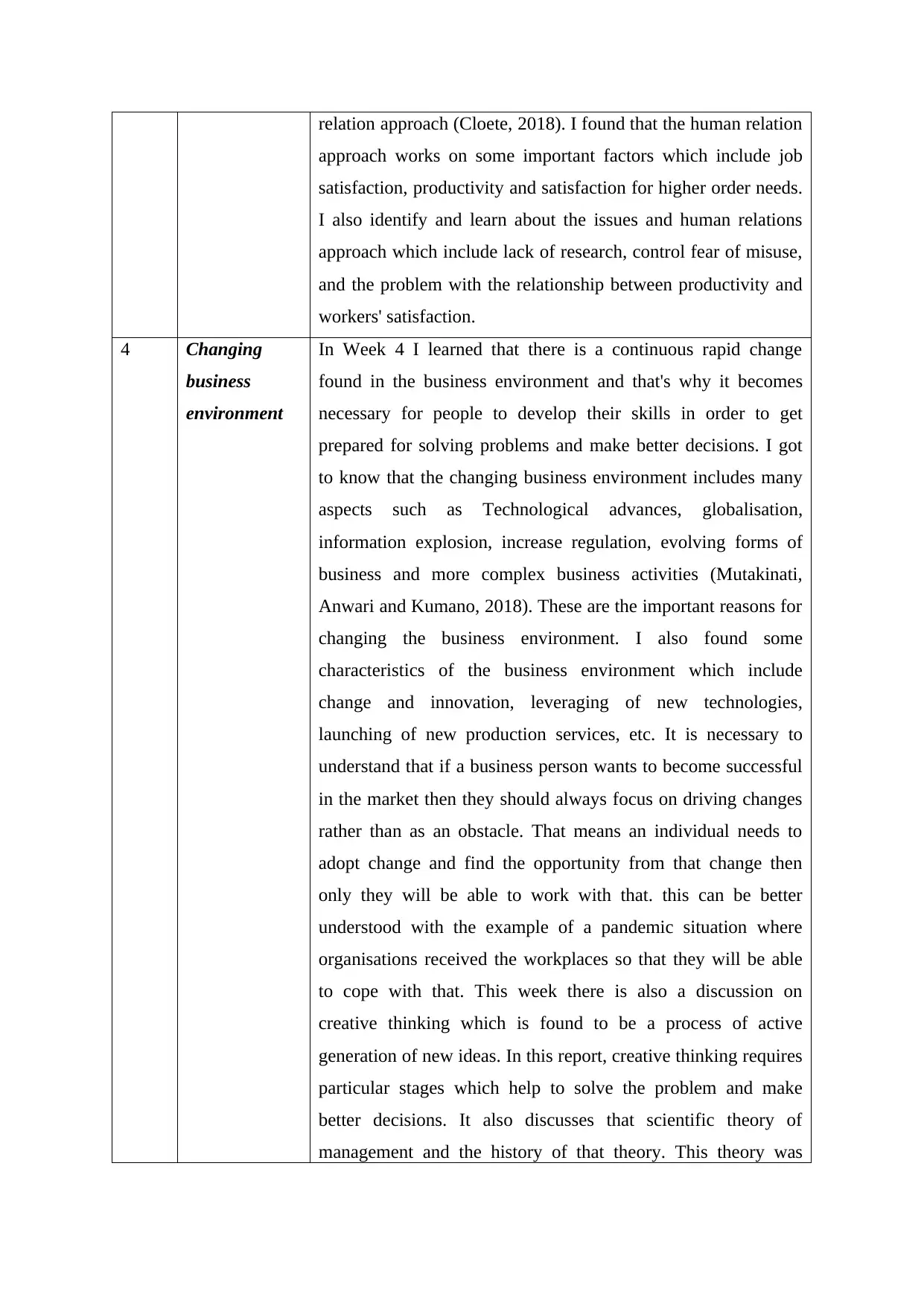
relation approach (Cloete, 2018). I found that the human relation
approach works on some important factors which include job
satisfaction, productivity and satisfaction for higher order needs.
I also identify and learn about the issues and human relations
approach which include lack of research, control fear of misuse,
and the problem with the relationship between productivity and
workers' satisfaction.
4 Changing
business
environment
In Week 4 I learned that there is a continuous rapid change
found in the business environment and that's why it becomes
necessary for people to develop their skills in order to get
prepared for solving problems and make better decisions. I got
to know that the changing business environment includes many
aspects such as Technological advances, globalisation,
information explosion, increase regulation, evolving forms of
business and more complex business activities (Mutakinati,
Anwari and Kumano, 2018). These are the important reasons for
changing the business environment. I also found some
characteristics of the business environment which include
change and innovation, leveraging of new technologies,
launching of new production services, etc. It is necessary to
understand that if a business person wants to become successful
in the market then they should always focus on driving changes
rather than as an obstacle. That means an individual needs to
adopt change and find the opportunity from that change then
only they will be able to work with that. this can be better
understood with the example of a pandemic situation where
organisations received the workplaces so that they will be able
to cope with that. This week there is also a discussion on
creative thinking which is found to be a process of active
generation of new ideas. In this report, creative thinking requires
particular stages which help to solve the problem and make
better decisions. It also discusses that scientific theory of
management and the history of that theory. This theory was
approach works on some important factors which include job
satisfaction, productivity and satisfaction for higher order needs.
I also identify and learn about the issues and human relations
approach which include lack of research, control fear of misuse,
and the problem with the relationship between productivity and
workers' satisfaction.
4 Changing
business
environment
In Week 4 I learned that there is a continuous rapid change
found in the business environment and that's why it becomes
necessary for people to develop their skills in order to get
prepared for solving problems and make better decisions. I got
to know that the changing business environment includes many
aspects such as Technological advances, globalisation,
information explosion, increase regulation, evolving forms of
business and more complex business activities (Mutakinati,
Anwari and Kumano, 2018). These are the important reasons for
changing the business environment. I also found some
characteristics of the business environment which include
change and innovation, leveraging of new technologies,
launching of new production services, etc. It is necessary to
understand that if a business person wants to become successful
in the market then they should always focus on driving changes
rather than as an obstacle. That means an individual needs to
adopt change and find the opportunity from that change then
only they will be able to work with that. this can be better
understood with the example of a pandemic situation where
organisations received the workplaces so that they will be able
to cope with that. This week there is also a discussion on
creative thinking which is found to be a process of active
generation of new ideas. In this report, creative thinking requires
particular stages which help to solve the problem and make
better decisions. It also discusses that scientific theory of
management and the history of that theory. This theory was
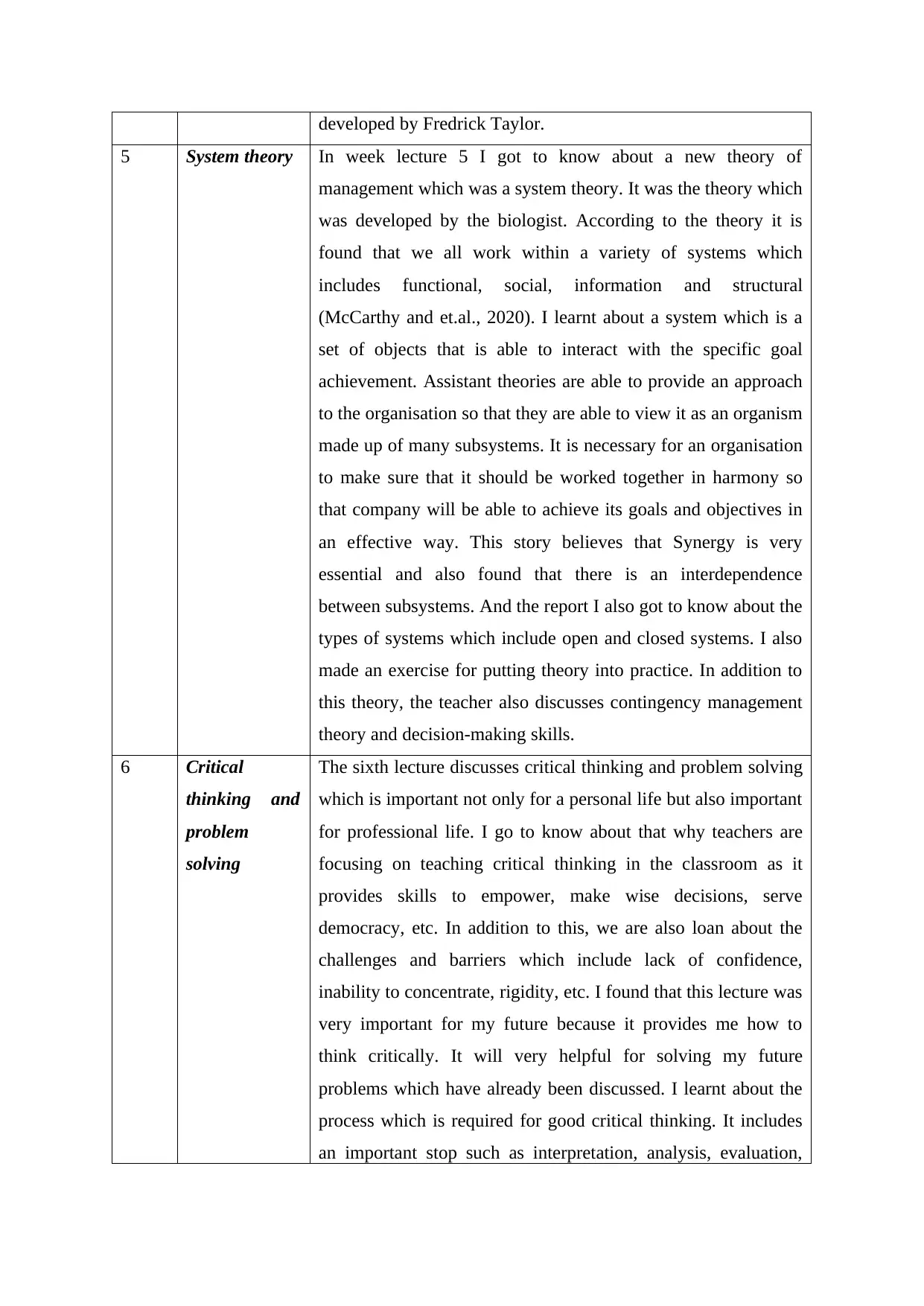
developed by Fredrick Taylor.
5 System theory In week lecture 5 I got to know about a new theory of
management which was a system theory. It was the theory which
was developed by the biologist. According to the theory it is
found that we all work within a variety of systems which
includes functional, social, information and structural
(McCarthy and et.al., 2020). I learnt about a system which is a
set of objects that is able to interact with the specific goal
achievement. Assistant theories are able to provide an approach
to the organisation so that they are able to view it as an organism
made up of many subsystems. It is necessary for an organisation
to make sure that it should be worked together in harmony so
that company will be able to achieve its goals and objectives in
an effective way. This story believes that Synergy is very
essential and also found that there is an interdependence
between subsystems. And the report I also got to know about the
types of systems which include open and closed systems. I also
made an exercise for putting theory into practice. In addition to
this theory, the teacher also discusses contingency management
theory and decision-making skills.
6 Critical
thinking and
problem
solving
The sixth lecture discusses critical thinking and problem solving
which is important not only for a personal life but also important
for professional life. I go to know about that why teachers are
focusing on teaching critical thinking in the classroom as it
provides skills to empower, make wise decisions, serve
democracy, etc. In addition to this, we are also loan about the
challenges and barriers which include lack of confidence,
inability to concentrate, rigidity, etc. I found that this lecture was
very important for my future because it provides me how to
think critically. It will very helpful for solving my future
problems which have already been discussed. I learnt about the
process which is required for good critical thinking. It includes
an important stop such as interpretation, analysis, evaluation,
5 System theory In week lecture 5 I got to know about a new theory of
management which was a system theory. It was the theory which
was developed by the biologist. According to the theory it is
found that we all work within a variety of systems which
includes functional, social, information and structural
(McCarthy and et.al., 2020). I learnt about a system which is a
set of objects that is able to interact with the specific goal
achievement. Assistant theories are able to provide an approach
to the organisation so that they are able to view it as an organism
made up of many subsystems. It is necessary for an organisation
to make sure that it should be worked together in harmony so
that company will be able to achieve its goals and objectives in
an effective way. This story believes that Synergy is very
essential and also found that there is an interdependence
between subsystems. And the report I also got to know about the
types of systems which include open and closed systems. I also
made an exercise for putting theory into practice. In addition to
this theory, the teacher also discusses contingency management
theory and decision-making skills.
6 Critical
thinking and
problem
solving
The sixth lecture discusses critical thinking and problem solving
which is important not only for a personal life but also important
for professional life. I go to know about that why teachers are
focusing on teaching critical thinking in the classroom as it
provides skills to empower, make wise decisions, serve
democracy, etc. In addition to this, we are also loan about the
challenges and barriers which include lack of confidence,
inability to concentrate, rigidity, etc. I found that this lecture was
very important for my future because it provides me how to
think critically. It will very helpful for solving my future
problems which have already been discussed. I learnt about the
process which is required for good critical thinking. It includes
an important stop such as interpretation, analysis, evaluation,
⊘ This is a preview!⊘
Do you want full access?
Subscribe today to unlock all pages.

Trusted by 1+ million students worldwide
1 out of 17
Related Documents
Your All-in-One AI-Powered Toolkit for Academic Success.
+13062052269
info@desklib.com
Available 24*7 on WhatsApp / Email
![[object Object]](/_next/static/media/star-bottom.7253800d.svg)
Unlock your academic potential
Copyright © 2020–2025 A2Z Services. All Rights Reserved. Developed and managed by ZUCOL.




